|

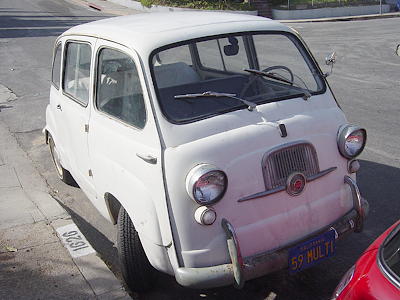
September
2006.
A sad, sad, day. I sold the Multipla! Yes, it's true. After much going
back and forth, I've decided to clean the entire collection... well almost.
The Multi, as loved as it is, is going to a new owner. No regrets... yet.
I think I had a great time throughout the entire affair. From finding
it, to getting it home, to finding someone to help me with it (thanks
by the way to all who helped!), to seeing it running and getting to drive
it for the first time. Man, that was an adventure. I'm sure it will bring
some good times to the new owner. I will continue to maintain this section
for a while as I've been getting a good number of questions and requests
for specific information. I still have my hands on additional info, so
keep an eye out! This page will change from its current format, documenting
my Multipla's progress, to a general Multipla information source. Hope
it helps out. :)
|
SOLD!!
Yes,
sad but true! I had to let my baby go!
Read below to see all that'd been done to it and additional pictures.
Click here to download the sale PDF flyer. Thanks!!
|
Yes, you
may have seen this text on some Multipla auctions and other sites before,
but this is where it comes from! By the way, no this is not a "club
site," it's my own personal site documenting some of my projects.
This particular page is specific to my Multipla's restoration. I hope
you can use some of the information here in your own project. Good luck
and enjoy!
Fiat
600 Multipla
Italy 1956-1966
So, what
is a Fiat Multipla, you ask? Well, it's a utility vehicle, a variant of
the Fiat 600, which is, itself, the Fiat 500's big (well, bigger) brother.
The Multipla was available in several configurations and bodies from at
least a couple of manufacturers. Mine is an early model with the 600cc
engine. It has a four speed transmission and locks the transmission when
the parking brake is engaged. The 600D models had a couple of additional
changes including a brake that engages the rear brakes instead of the
transmission.
But more
on its history:
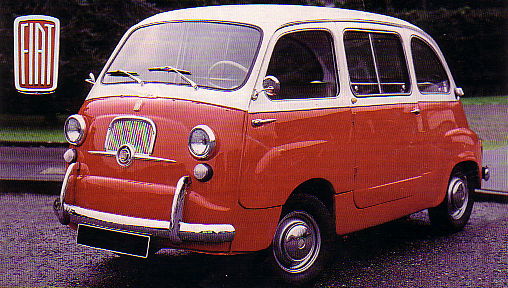 The
popularity of the Fiat
600 as well as the need for a larger capacity cargo vehicle to compete
and compliment vehicles like the Giardinera, gave Dante Giacosa, Fiat's
Director of Engineering in the 1950s, the opportunity to expand the 600
line to include an additional vehicle with exceptional cargo space and
three passenger configurations - the Multipla. The
popularity of the Fiat
600 as well as the need for a larger capacity cargo vehicle to compete
and compliment vehicles like the Giardinera, gave Dante Giacosa, Fiat's
Director of Engineering in the 1950s, the opportunity to expand the 600
line to include an additional vehicle with exceptional cargo space and
three passenger configurations - the Multipla.
It can be said that the design of the Multipla was not an easy feat. The
600 model was in its maturity and likely to change soon and it carried
its trademark rear-engine design and really posed an difficulty in providing
a flat cargo-carrying floor. Space equivalent to the Belvedere was only
possible by pursuing the only logical solution - moving everything to
the front, including the driver area. This caused a rather ingenious driver
position whereby stradling the steering column is necessary. The spare
tire was moved to the front passenger section limiting leg room in that
seat. The Multipla did not have a rear door but nonetheless it provided
excellent rear compartment access for both passenger and cargo due to
the large side doors. The passenger versions included a 6-passenger layout
with three rows of seats and a 4-5 passenger version with a fold-down
cargo section which could also be converted into a camping bed. The taxi
version replaced the front passenger seat with additional luggage area.
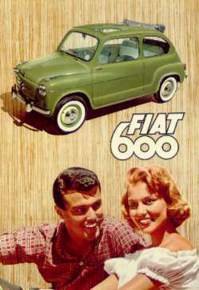
 Super Compact!
Super Compact!
Even
with all its room for cargo and passengers, the Multipla was a marvel
of compact design! |
|
|
Mutipla
|
500
|
New
Mini
|
|
Width
|
57.1"
|
56.1"
|
66.5"
|
|
Length
|
139.4"
|
127.0"
|
143.9"
|
|
Height
|
62.2"
|
|
55.8"
|
|
Even with
all its room for cargo and passengers, the Multipla was only 12in (305mm)
longer and 1in (25mm) wider than the Fiat 500! To give you an idea of
its size, the Multipla is about 4'6" wide and a little over 5' tall.
It's a bit over 11' long. That makes it shorter and narrower than a new
Mini Cooper and just a little bit taller than one.
The most
important challenge of the design, however, was to ensure that the Multipla
did not lose its 600 identity, and figuring it's only 10in (254mm) longer
than the 600 sedan, one can speculate that this was no easy feat. The
front design was imposed by the driver's forward position. The rear design,
it was decided, would be practically identical to the sedan and uses some
of the same parts, including the rear suspension components. The final
design, coded "110-" was ready in 1953 with the intention of
beginning production in 1955. The Multipla was officially introduced in
Brussels in January of 1956 to a myriad of public opinions. The Multipla's
true attributes were immediately apparent and it quickly became a public
favorite. It's "suicide" doors were situated immediately above
the front wheel wells and allowed for an interesting entry position. Once
inside, the driver gets the impression of being too far forward much like
driving a small bus. The driver controls were no less peculiar, with the
driver straddling the steering column. Another needed aspect of the design
was the position of the spare tire, which is situated inside the cab by
the co-pilot's feet.

The
Power Pack - Pint-pot Motor
The
Multipla uses the same 633cc rear-mounted engine as the Fiat 600 sedan.
This means a water-cooled four-cylinder unit that is compact and returns
good gas mileage. The cast-iron cylinder block has an integral upper
crankcase and an aluminum cylinder head. The whole engine/transmission
unit weighs a mere 238 lbs. With a 7.0:1 compression ratio an d a
single Weber carburetor, it produces 22 bhp. In 1960, the engine was
enlarged to 767cc and power went up to 32 bhp.
|
The rear
area, by contrast, has an incredibly easy access. Used as a camper, the
5-6 passenger model could recline all seats making a nice size mattress
inside. As a cargo vehicle, the rear seats fold forward to provide a flat
space capable of carrying sizeable load.
|
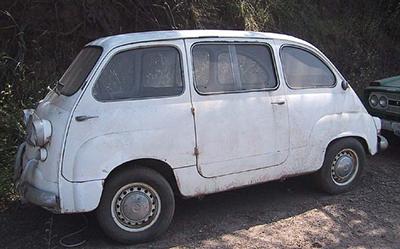
MY MULTIPLA.
This
is the way it was the first time I saw it minus the blue tarp covering
it. It had sat here for a while so it was absolutely dirty. Getting
it home was an absolute adventure than involved a rented trailer,
rented ratchet to pull it up on the trailer only to find the wheel
track is too narrow for a regular trailer. Drive back to L.A. and
hire a flatbed to transport. Absolutely worth it, though. Notice
the 13" rims that it's running on (from an 850)... well, on
this side. The other side had original 12" wheels. It's now
much cleaner, though!
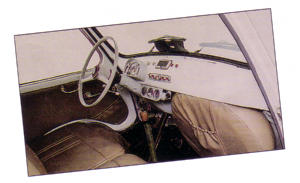
Its cab-forward
design makes driving
the Multipla feel like driving a tiny bus.
 Vital Statistics
Vital Statistics |
| Top
speed |
62
mph |
| 0-60mph |
54.0
sec. |
| Engine
type |
In-line
four |
| Displacement |
633cc |
| Max
power |
22
bhp at 4,600 rpm
|
| Max
torque |
29
LB-ft at 2,800 rpm |
| Weight |
1,624
lbs |
| Gas
mileage |
40
mpg |
| Price |
$1,598 |
|
 Value Guide (1995)
Value Guide (1995) |
| Original
price 1957: $1,598 |
| Current
value: $2,000-$8,000 |
| Production
Total: 160,260 |
| These
are 1995 prices quoted here. And by the way, I've seen
how other auctions change this so these are the actual figures
I had from previous literature. I've seen these prices go substantially
higher in the past few years so it's good to see they're appreciating. |
|
During its
10-year production run, a total of approximately 160,000 units were produced
with some modifications throughout its model life pretty much in tune
with its 600 sedan counterpart. This included a larger engine with the
introduction of the 600D models as well as the same windows for the front.
They also shared some mechanical components, not the least of which were
the engine and transmission as well as the rear suspension. The gearbox
was modified by 81mm to accomodate the longer length. Due to its increased
weight, the Fiat 1100's front suspension was used.
When the
laws changed in Italy requiring all vehicles to offer "normal"
opening doors, the Multipla suffered its untimely demise due to its inability
to change its design to accomodate the new rules. Sadly, after only 10
years, the Multipla went the way of the dodo bird. Few examples of this
great car remain which makes this one extra special to yours truly.
It is generally
accepted that the 1983 Dodge Caravan was the original minivan, but almost
30 years earlier
Fiat had introduced the granddaddy of them all. In a masterstroke of packaging,
the 600 Multipla could squeeze six passengers into a body that measured
under 12 feet.
The best
way to describe the Multipla is idiosyncratic. It's like no other vehicle.
The driving position is similar to a VW bus - you sit upright with the
wheel horizontal in front of you. The Multipla is no hare in action, and
when fully loaded, the progress is slow. While roadholding is good, the
handling can be tail happy if the little van is driven too fast. For all
that, driving a Multipla can be great fun because it is so unique.
Forward
Control
The Fiat
600 replaced the old "Topolino" Fiat in 1955, but a station
wagon version was almost impossible to engineer around the rear-mounted
engine. The solution was to move everything forward. The Multipla's platform
is virtually identical to the 600 sedan; it has the same tiny wheelbase,
but is 10 inches longer and has slightly wider front and rear treads.
Naturally, there are some differences, notably to the steering gear.
Cult
Minivan
It would
not be unique to say that the Multipla has a cult following. It's a historic
machine in one way - as the very first of the minivans - but it also has
a design cuteness and a practicality that puts rivals in the shade. It's
rare today, too, making it more valuable than the straight 600 sedan.
In Italy,
the Multipla became an icon, a jack-of-all-trades that could act as a
people carrier, small truck, taxi, camper, or regular sedan. Its styling
and layout may look odd but it worked well - and at a bargain price!
'Suicide'
front doors
Like
many European small car designs of this area, the front doors hinge at
the rear to provide better access for the driver and front passenger.
The obvious safety implications of this setup led to the nickname 'suicide'
doors.
Rear-mounted
engine
The
small four-cylinder powerplant sits at the rear of the car and is easily
accessible for servicing. It is unusual in that it incorporates the transmission
within it as a single unit, saving weight and complexity.
600 chassis
It
may look like a mini truck, but the Multipla is based on the platform
of a Fiat 600 sedan. The wheelbase and rear engine/suspension are identical,
although the steering, track and front suspension are altered.
Fiat
1100 front suspension
To
cope with the extra weight over the front axle, the transverse leaf spring
suspension of the 600 was substituted by the coil springs and anti-roll
bar from the larger 1100 sedan.
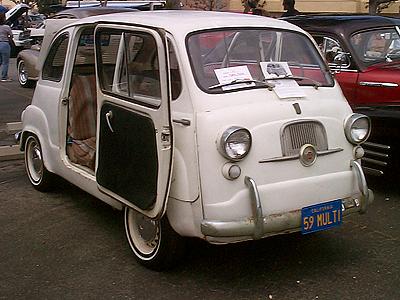 So
now that you have some general information on the Multipla, here
is some detail specific to my Multipla: So
now that you have some general information on the Multipla, here
is some detail specific to my Multipla:
My
Multipla
I
got my Multipla early in 2005 in Southern California. I'd been looking
for one for y-e-a-r-s and was lucky enough to find one that was in decent
shape and better yet, I could afford. Don't get me wrong, it needed
tons of work but it is a
Multipla!
Here
is the latest:
March
2006 update:
It lives!!! As you can see from the picture above, the Multipla is back
home and parked on the street! Yep, street legal and running!
I've been taking it out on short rides here and there to break the engine
in. It got a major overhaul including some machine work and I want to
make sure everything sits in correctly. Yes, it gets tons of looks and
questions. The turning radius is incredible. I had to remember not to
turn the wheel too sharply because that actually had me sliding sideways
in the seat. It's a funky transition to drive the Travelall
and then the Multipla. The Travelall requires about a dozen turns of
the steering wheel to make a turn, so when I switch to this and automatically
do the same with the steering wheel, the results are quite interesting.
I love it.
May
2006 update: We
just took the Multipla to its first car show! No awards, but it was
just fun driving it some 15 miles each way through Los Angeles. It was
all good. There was a constant flow of people checking it out and a
million questions.
Engine
- Wow! Sweet!!
-
It
wasn't there when I got it! Well, it was, but was missing some parts.
Condition unknown, but it turned. The carburetor was not there, and
I could see water got in. No muffler, no air cleaner. Just a disaster,
but I did score on a ton of parts which completed most of the engine.
- Fixed!
Yes, I now have before and after pictures of the engine!! Not
too shabby, eh? The bottom picture is from the day I got to start the
engine for the first time! I wonder how long it'd been since that happened.
I'm guessing some 20 years at least, because the last paperwork I have
is all dated from the early 80s. Thanks to Vittorio at Alfa Italia in
Burbank.
- The list
of items replaced during the engine work is ex-ten-sive! Here is a small
sample:
- NOS
muffler
- NOS
fuel pump
- NOS
piston set
- All
gaskets on engine
- Main
bearings
- Rod
bearings
- Front
and rear seals
- Rebuilt
the oil pump
- New
rotor and distributor
- Rebuilt
carburetor
- All
new hoses all around
- All
new cables, including choke, throttle, and starter
- New
clutch
- Rebuilt
transmission
- New
battery
- Extensive
machining to get it just right
Brakes
- Fixed!!
- Front
passenger-side hub was locked and rusted out
- Master
cylinder was cracked and leaking.
- Fixed!
Found a NOS master cylinder, all wheel cylinders and replaced the entire
thing. All new hoses, pads, cylinders, and every other incidental. It
stops!
Transmission
- Fixed!!
- Completely
rebuilt transmission. Like butter. Non-synch 4-speed. Including a new
clutch!
Electrical
- Fixed!!
- I was
having some issues with the horn but that's working now. It's very old
so I may replace that if I find an original one.
- Brakelights
good
- Headlights
good and high beams good
- Parking
lights good
- Signals
good
- Instrument
panel lights good (dial pod, indicator lights for high-beam, signals,
etc.) good
- The only
things that remain are the license plate light and to connect two auxiliary
gauges. These work and the adapters are in the engine, but I've just
not run the wires in anticipation of beginning the bodywork.
Glass
- Good!
- Glass
is 99.9% good. There is a small pebble nick on the windshield and a
small chip on the front passenger side window. I have a source for the
windshield (FiatPlus.Com), so now it's just a matter of figuring out
how to get it here. I bought a set of doors but they have yet to arrive!
I'm starting to think they won't but I'm hoping they do. If so, the
car will end up with a full set of glass all around (I'll pass these
doors on to the buyer at cost if interested!) I have a full set of the
rearmost side windows which will be included in the sale.
- I would
not mind replacing the rear brake light lenses, but have not been able
to find those. They are not cracked or anything, but just a little faded
from age. Update! I found a NOS set of Lucas lenses! Original
Lucas L523 in red. When I replaced them, I noticed that the original
lenses were amber, which was allowed at the time. I found a source for
the amber lenses and may replace those at some point. For now, though,
it will run with red lenses on the rear.
Tires
- Good!
- Tires
were shot. When I got the car, it was running... well, rolling... well
sitting on two 13" tires on one side and two 12" tires
on the other. I did not get the 12" rims until later and I needed
to move it around so I bought a set of 13" tires for it in the
meantime (the rims it now sports are for the 850). I have 6 12"
rims but no tires on those yet. I did not want to put tires on those
until I decide on the color and put the hubcap clips on them. Besides,
I've been driving the car with the 13" wheels, and I must admit
that it is very comfortable with those. The ride is smooth and the tires
are brand new but I am looking for a set of 12" whitewalls to eventually
put in the car.
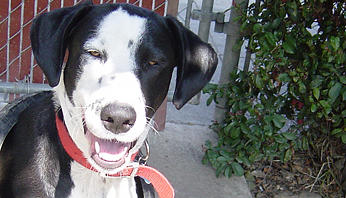
Roscoe.
The face says it all. Not sure if you can see, but he's actually "wearing"
his favorite toy. Some old tire which I've no idea where he got it
from. Not sure why we even bother to buy him toys sometimes. |
Field
mouse family - Evicted!
- Evicted
field mouse family from battery tray. These came free with the car when
I bought it, but sadly will not be included in the sale as they are
gone! Get this. We have a dog, well, we have three. Roscoe, the dog
in question here, was nearly poisoned in the process of the mouse eviction.
Roscoe managed to get in the car, open the battery tray and eat the
rat poison, which I thought I'd hid pretty well. We spent a wonderful
night at the emergency vet, me sitting in a waiting room with old magazines
and him getting his stomach pumped followed by a good dose of charcoal.
This is the dog, mind you, that got stuck in a tree chasing a squirrel,
got stuck under a fence chasing I have no idea what, somehow ended up
chained at the neighbor's yard, stuck between my neighbor's and my fence,
and was chasing my other neighbor's birds, so getting in trouble hunting
the mice was not that surprising. Oh, he almost got stuck climbing under
the engine bay to the passenger compartment in the process.
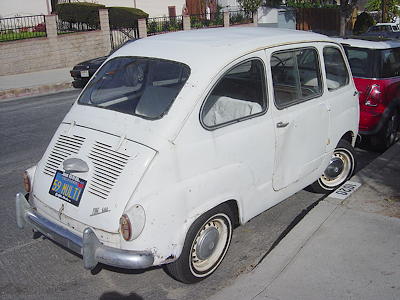 Interior
- Work in progress Interior
- Work in progress
- The Multipla
had about three coats of dirt and mud on it. The seats are actually
black up front, a color that I did not discover until about 1 1/2 buckets
of water into the cleaning process. Right now we're in the process of
trying to figure out what to do about them. I think black and white
will look just right. The front seat and all panels are black and the
rear seat is green. It looks like the panels were painted from their
original green at some point. I will probably redo the rear seat in
black as an interim solution and then, once the bodywork is done, redo
the entire thing really nice.
- There
is no headliner and there are a few very minor dents on the roof that
I need to fix before I put anything there. They can be pushed out by
hand so it should be no big deal. I even thought of cannibalizing an
old 600 and taking the sunroof assembly but who knows.
- There
is no carpet to the back part and some parts appear to be home made.
I'll have to research this a bit more, but I refuse to believe Fiat
used wood for some of those part but maybe if they were covered with
carpet I can see how that could be.
- I think
I have a full set of original mats but they are in pretty dire shape.
I may have to resort to carpeting the whole thing.
Bodywork
- Work in progress
- There
is some work to do in this area. One rear door has some small dents
in it and could use some attention. I found a full set of doors in excellent
shape (which I've YET to see), so I may not try to monkey around with
these, I'll replace them with a good set. Well, that's the current plan.
We'll see how that pans out.
- The roof
has some minor dents that need to be worked out. Nothing major, but
on closer inspection you can see them.
- The rear
quarter panel on the passenger side has some rust through (see picture).
Nothing major again, but will need to be fixed.
- The floors
have some rust through. The driver side was repaired at some point but
not to original specs. I found some reproduction floors in the original
patterns somewhere in Germany and also on eBay, so I may bring those
in when the bodywork begins.
- Pillars,
front, engine compartment all seem in really good shape.
- I was
at Tony's
in Eagle Rock, where some of the brake work was done and found out he's
building a body shop!! Super stoked because I trust Tony completely
and know his guys will do a killer job on the body once they open for
business.
CA DMV
paperwork - Done!!
- After
about a dozen trips to DMV, it's under my name, titled, with the personalized
plates, insured, etc., etc. It's a 100% street legal car!
I'm
still collecting some parts for the body restoration, but now that I
know that the engine, transmission, electrical, and most important DMV
stuff is good to go, then I feel better about going forward on this.
If you feel you must have it, please hit
me up. I'm always open to entertaining offers. I can provide you
with all the receipts for all the stuff that's been done to it to date
and whatever else is done to it while it's with us.
Here's what's coming up:
- Floor
repair
- Rust repair
on rear passenger-side fender
- Slight
bodywork to roofline and other small dents on doors
- Find all
rubber
- Replace
13" 850 wheels (what it has on), with the original 12" ones.
I have 6 rims, so I'm good there.
- Paint
- Restore
chrome items
- Upholstery
and carpeting
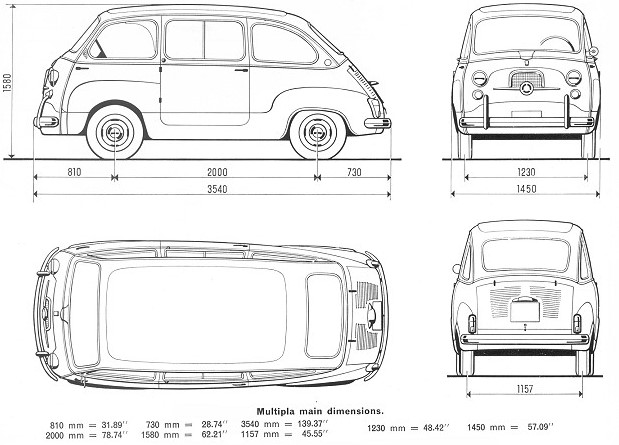
|
![]() VespaApe.Com
VespaApe.Com![]() Rear
Engine Fiat Club
Rear
Engine Fiat Club![]() Tony's Import
Car Service & Undercar Repair
Tony's Import
Car Service & Undercar Repair![]() Fiat Plus
Fiat Plus
![]() Steering
diagram
Steering
diagram ![]() Electrical diagram
Electrical diagram ![]() AutoCar Road Test
AutoCar Road Test![]() Parts manual
Parts manual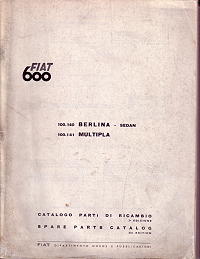
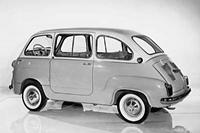
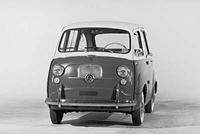
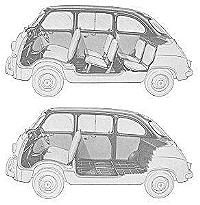






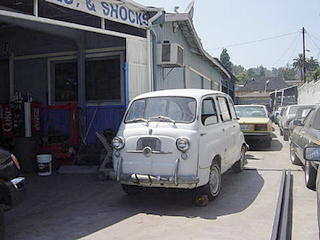
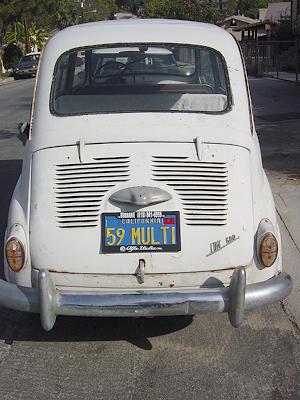
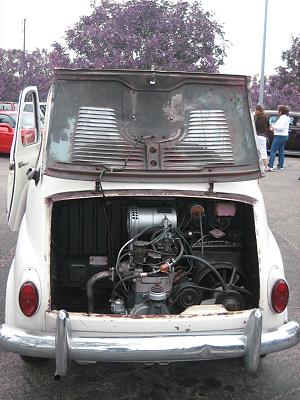
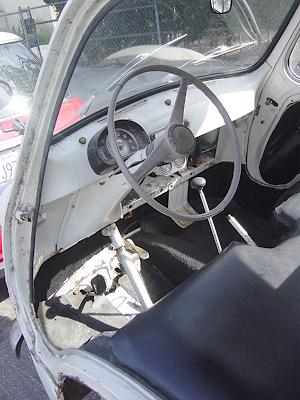



 The
popularity of the
The
popularity of the 



 So
now that you have some general information on the Multipla, here
is some detail specific to my Multipla:
So
now that you have some general information on the Multipla, here
is some detail specific to my Multipla: 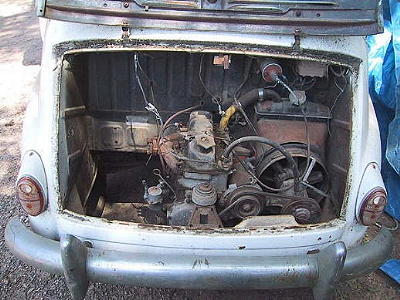
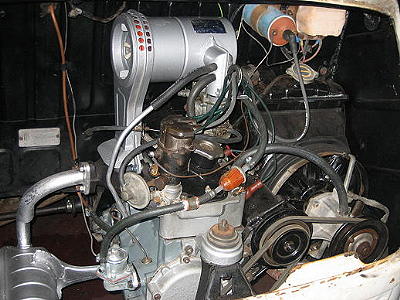
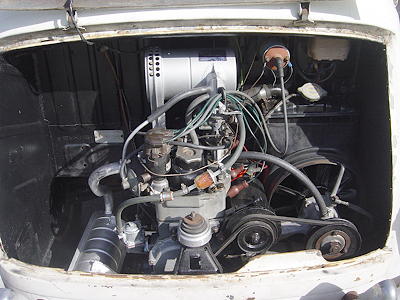
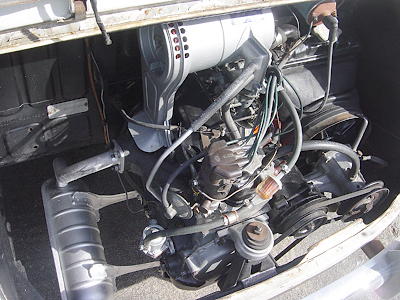
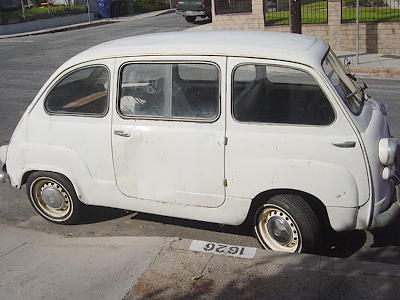

 Interior
- Work in progress
Interior
- Work in progress 